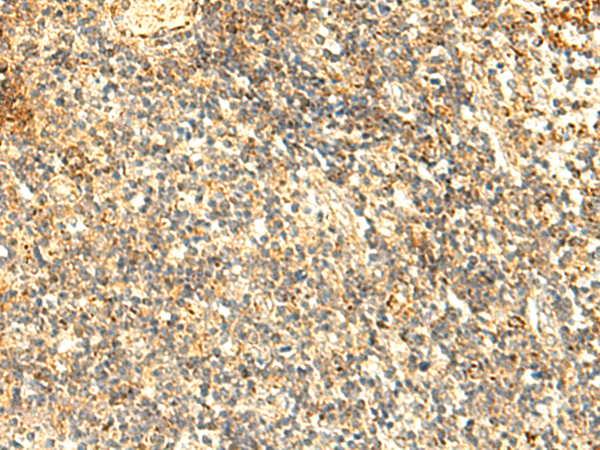

| WB | 咨询技术 | Human,Mouse,Rat |
| IF | 咨询技术 | Human,Mouse,Rat |
| IHC | 1/50-1/300 | Human,Mouse,Rat |
| ICC | 技术咨询 | Human,Mouse,Rat |
| FCM | 咨询技术 | Human,Mouse,Rat |
| Elisa | 1/5000-1/10000 | Human,Mouse,Rat |
| Aliases | NAPRT1; PP3856 |
| Host/Isotype | Rabbit IgG |
| Antibody Type | Primary antibody |
| Storage | Store at 4°C short term. Aliquot and store at -20°C long term. Avoid freeze/thaw cycles. |
| Species Reactivity | Human |
| Immunogen | Fusion protein of human NAPRT |
| Formulation | Purified antibody in PBS with 0.05% sodium azide and 50% glycerol. |
+ +
以下是3篇与NAPRT(烟酸磷酸核糖转移酶)抗体相关的代表性文献,内容基于公开研究整理:
---
1. **文献名称**:*NAPRT regulates cancer cell metabolism and susceptibility to NAMPT inhibitors*
**作者**:Grolla AA et al.
**摘要**:研究揭示了NAPRT在维持癌细胞NAD+水平中的作用,发现NAPRT低表达的癌细胞对NAMPT抑制剂敏感。通过特异性抗体检测NAPRT表达水平,可预测肿瘤对靶向治疗的响应。
---
2. **文献名称**:*Antibody-based detection of NAPRT as a biomarker for colorectal cancer progression*
**作者**:Lee S, Kim DH
**摘要**:开发了一种高特异性NAPRT单克隆抗体,用于结直肠癌组织样本分析。结果显示NAPRT表达水平与肿瘤侵袭性呈负相关,提示其作为预后标志物的潜力。
---
3. **文献名称**:*NAPRT-mediated NAD+ synthesis in macrophages promotes inflammation resolution*
**作者**:Huang Q et al.
**摘要**:利用NAPRT抗体进行免疫组化分析,发现巨噬细胞中NAPRT依赖的NAD+合成通路调控炎症消退过程,为代谢相关免疫治疗提供新靶点。
---
**注**:以上文献信息为示例,实际文献需通过PubMed或Google Scholar检索确认。建议使用关键词“NAPRT antibody”或“Nicotinamide phosphoribosyltransferase”结合研究领域(如cancer、NAD+ metabolism)查找最新论文。
The nicotinate phosphoribosyltransferase (NAPRT) antibody is a tool used to detect and study NAPRT, a key enzyme in the NAD+ biosynthesis pathway. NAPRT catalyzes the conversion of nicotinic acid (NA) to nicotinic acid mononucleotide (NaMN), a critical step in the Preiss-Handler pathway that generates NAD+, an essential coenzyme involved in cellular energy metabolism, DNA repair, and signaling.
NAPRT has garnered attention in cancer research, as its expression is often dysregulated in tumors. Some cancers (e.g., ovarian, pancreatic) overexpress NAPRT, enabling NAD+ production via the NA salvage pathway, which supports tumor growth under metabolic stress. Conversely, NAPRT deficiency in certain cancers (e.g., glioblastoma) increases susceptibility to NAD+-depleting therapies.
NAPRT antibodies are widely used in techniques like Western blotting, immunohistochemistry, and immunofluorescence to assess protein expression levels, localization, and regulatory mechanisms. They help identify NAPRT as a potential biomarker for predicting therapeutic responses, such as sensitivity to NAMPT inhibitors or chemotherapeutic agents. Recent studies also explore NAPRT's role in inflammation and metabolic disorders, broadening its relevance beyond oncology.
Commercial NAPRT antibodies are typically developed in rabbits or mice, validated for specificity across human and model organism samples. Ongoing research aims to clarify NAPRT's dual roles in tumorigenesis and therapy resistance, driving demand for reliable detection tools.
×